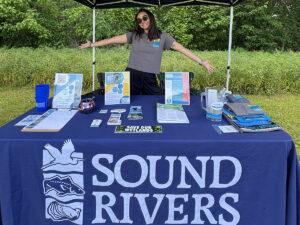News
Emerging Contaminants in Your Water
Education, Environmental, Regulatory
Posted on November 1st, 2018
Your Riverkeepers have been monitoring the emerging contaminants situation on your rivers for some time now; you may recognize “GenX” from the news – it appeared in drinking water in the Cape Fear River Basin – but there are many other chemicals polluting our river that fall into the same category. 
Per- and polyfluoroalkyl substances are forms of perfluorooctanoic acids (PFOAs), a class of synthetic, toxic compounds used to produce products such as non-stick pans, firefighting foam, and stain-resistant fabrics. PFOAs are synthetic compounds that have been produced for decades and can be found in products such as furniture, cosmetics, clothing, cookware and food packaging. Once they reach our water supplies they are there to stay, persisting for upwards of thousands of years.
These compounds have been detected in many rivers in North Carolina. PFOAs are just one of thousands of so-called “Emerging Contaminants” that are currently not regulated and neither industry nor our state (DEQ) or federal (EPA) regulators are required to conduct water quality tests for it. Emerging contaminants are important because they pose a risk to health and to the environment, yet these chemicals are not yet fully understood.
Through funding appropriated in the state’s budget, the North Carolina Policy Collaboratory has begun to study these chemicals. Research teams from universities across North Carolina will be looking at a number of different projects, including:
- Sampling public water sources statewide to establish a baseline and monitoring protocol moving forward.
- Examining air emissions to better understand how air particles may impact water on and under the ground.
- Developing models to predict which private water wells are at greatest risk of PFOAs contamination.
- Assessing the impact of PFOAs on public health and testing the performance of technologies in removing them.
Your Upper Neuse Riverkeeper continues to play in important role in the stakeholder process and is currently sampling the Neuse River for compounds. Only by knowing what chemicals are present, can we then begin the process of eliminating the source of these pollutants.
Related News

Swim Guide volunteers needed!
May 8th 2025

Riverkeeper hops watersheds to share Sound Rivers mission
May 8th 2025

Riverkeeper reacts to Lake Crabtree Park closure
May 8th 2025

Girl Scouts take on Jack’s Creek
May 8th 2025

Durham council approves Howard property development
May 8th 2025

Adkin Branch tour a precursor to watershed restoration plan
May 8th 2025

Sound Rivers loses AmeriCorps staff member
May 8th 2025

Students swept away by ‘Stormwater Week’
May 1st 2025

